Derby endured their 10thsuccessive season in the Championship in 2018. Their decade long stay in the Championship nearly ended, failing to gain promotion in an agonising play-off semi-final defeat to Fulham. Derby have been going close to promotion in recent times and will be hoping they can get over the line soon.
All the club’s efforts were put towards promotion, leading to poor cup performances in 2018.
Off the pitch, Derby saw their losses fall to almost zero, dropping from £21.2m to £1.1m after taking the dramatic step of selling Pride Park to their owners and leasing their stadium back from their owners, a move that has come into plenty of criticism.
Let’s delve into the numbers.
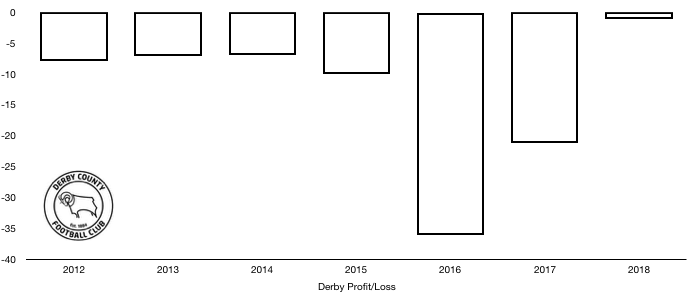
Revenue Analysis
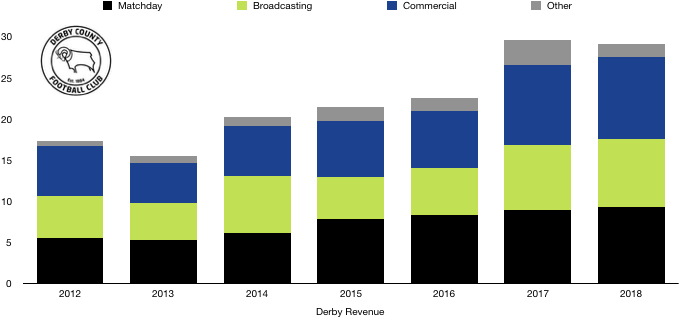
Derby saw revenue drop slightly, falling from £29.6m to £29.1m (2%) despite a successful season.
Matchday revenue increased from £8.9m to £9.3m (4%) despite average attendance falling from 29,042 to 27,175 (7%). This rise was because Derby benefitted from a bumper pay-out from their FA Cup tie with Manchester United.
Derby will hope to reduce this worrying trend of falling attendances, with the appointment of Lampard likely to help with this objective.
Broadcasting revenue rose from £7.9m to £8.3m (5%) on the back of an increase in the Premier League basic award to £200k plus Derby finished 3 places higher in the Championship.
Commercial revenue increased slightly from £9.8m to £9.9m (1%). Derby should look to capitalise on the increased interest in the club following the appointment of Chelsea legend Frank Lampard.
Other revenue fell from £3.0m to £1.6m (47%), the main reason for the fall in revenue, although what this relates to is not disclosed.
Looking ahead, revenue is likely to increase slightly after another solid season that may end in a play-off place, with the club currently sat in 6thwith two games remaining.
Broadcasting revenue hence will be similar and matchday revenue is likely to remain stagnant. Commercial revenue may increase slightly after another solid season.
A return to the Premier League via the play-offs will also boost revenue slightly this year before increasing to astronomical levels the season after, with a £100m+ boost likely.
Costs Analysis
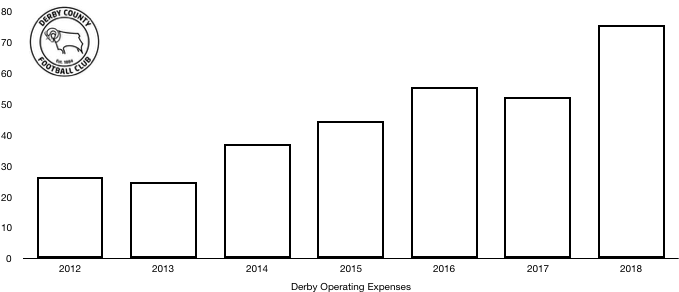
Derby saw their costs balloon despite stagnant revenue, hurting profitability considerably.
Costs rose from £52.4m to £75.8m (45%), a huge increase as they looked to gain promotion.
Amortisation rose from £5.1m to £6.6m (29%) as investment in the playing squad grew as the club showed ambition to return to the Premier League after a decade long absence.
Youth development expenditure grew from £4.0m to £4.6m (15%) as Derby continued to invest in their future in the hope unearthing their next big talent.
Interest costs fell to zero from £0.7m after a significant change in their debt profile (see debt analysis).
Derby paid no tax due to making a loss this year.
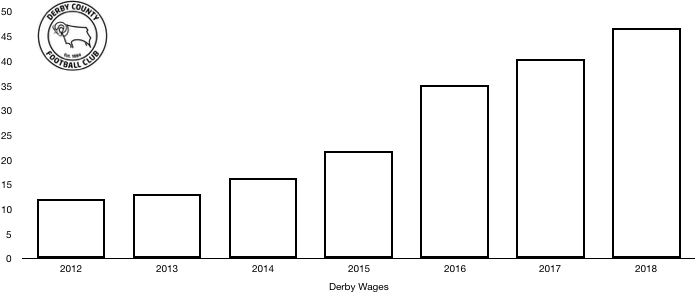
Wages rose from £40.5m to £46.8m (16%) after new signings signed on lucrative terms and existing key players were rewarded with new contracts.
This wage increase works out at an extra £121k a week, a sizeable increase for a Championship side with an already sizeable wage bill.
Directors saw their pay cut from £1.2m to £0.8m (33%).
Derby also pocketed £1.9m in compensation when they allowed Gary Rowett to join Stoke in the summer.
Looking ahead, Derby will see a further rise in costs with the marquee managerial appointment of Lampard and increased transfer activity last summer. Any increases in costs are likely to stretch Derby’s finances and further increase Financial Fair Play scrutiny.
Transfers Analysis
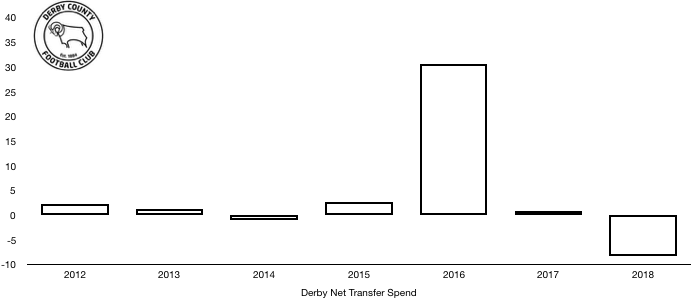
Derby were fairly busy in the transfer market with 5 signings and 4 departures during the season.
In came Lawrence (£5.0m), Wisdom (£2.1m), Huddlestone (£2.0m), Jerome (£1.5m) and Davies (£0.5m) for a combined £11.0m.
Departing Pride Park were Ince (£8.2m), Hughes (£8.2m), Christie (£2.5m) and Russell (£0.3m) for a combined £19.2m.
This led to a net transfer income of £8.2m, ending 3 consecutive seasons of net transfer spends.
The loss of key players in Ince, Hughes and Christie may have been the difference between promotion and their agonising play-off defeat. Despite this, the signings made all contributed to a good season, with Davies proving to be a great signing.
The player sold led to a profit on player sales of only £3.7m, with the sale of Hughes taken into account last year.
In cash terms, Derby spent cash of £19.5m and received cash of £22.3m, a net cash inflow of £2.8m, a small boost to their coffers.
This cash is likely to be needed to repay transfers soon with Derby owing other clubs £12.9m (£9.9m due this year) and the club only being owed £2.3m (none due this year). This £10.6m liability is likely to affect transfer plans going forward.
Derby could also potentially owe £19.2m should certain clauses be met in player contracts and transfer deals, although it is unlikely all of this will ever become payable.
Debt Analysis
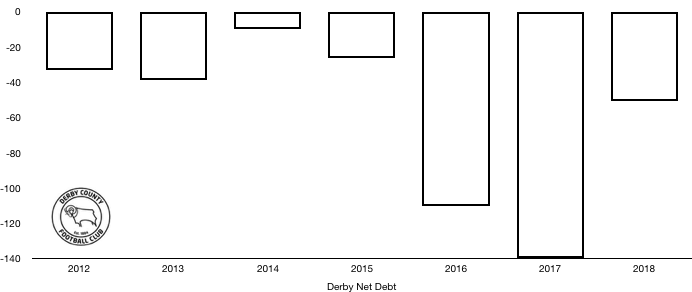
Derby had an interesting year in terms of finances after taking the bold step to sell Pride Park to their owners for £81.1m.
Despite this sale, cash levels fell from £4.1m to £3.2m (22%), highlighting the depth of their financial issues.
A profit of £39.9m was realised on the sale, meaning a loss of over £40m would have been recorded without this sale which would have almost certainly seen the club break Financial Fair Play rules.
The sale was used to fund these losses and their increased costs and also allowed Derby to spend £3.4m on improving the club’s infrastructure.
As well as selling their stadium to their owners, debt levels fell from £143.7m to £54.0m (62%) in consideration for the sale of the stadium.
Morris also essentially waived some of this debt, capitalising it as equity so it will not be repayable in a bid to make their finances look better. Morris also lent a further £22.9m after these accounts were released to further boost finances.
Net debt hence fell from £139.6m to 50.8m (64%) as the sale and leaseback was entered into to try and calm Financial Fair Play concerns after their compliance was questioned by Middlesbrough’s owner.
Derby have looked to ease fans concerns by confirming there are multiple restrictions in the terms to protect the interest of the football club. It was deemed a necessary decision in the short term, with promotion the key to relieving these issues.
A return to the Premier League is vital to the future of the club with another few seasons in the Championship likely to see their finances unravel as their losses mount.
Thanks for reading – Share with your football community!

